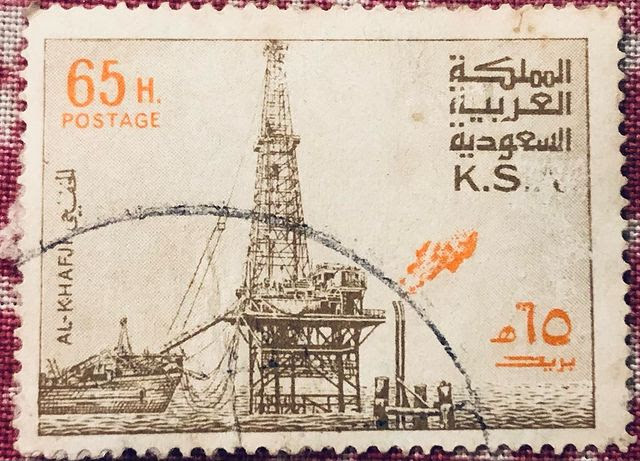Al Khafji stamp – Saudi Arabia, 1976 depicts the oil production at Al khafji oil fields in Saudi Arabia. Ras al-Khafji is a town on the border between Saudi Arabia and Kuwait. It lies in what was before 1970 the Saudi Arabian–Kuwaiti neutral zone.
About Ras-Al-Khafji
Ras al-Khafji is a town on the border between Saudi Arabia and Kuwait. It lies in what was before 1970 the Saudi Arabian–Kuwaiti neutral zone. The Japanese-owned Arabian Oil Company Ltd signed a concession agreement with the government of Saudi Arabia in December 1957 and with the government of Kuwait in July 1958 for exploration and development of hydrocarbon reserves in the offshore Neutral Zone. The Arabian Oil Company discovered the Khafji oil field in 1960 and the Hout oil field in 1963.
It was only after the discovery of these oil deposits off-shore of Khafji that a permanent demarcation of the neutral zone between Kuwait and Saudi Arabia was established, with Khafji formally located within Saudi Arabia. However, the agreement concluded that both states would still maintain joint rights to all natural resources within the designated neutral zone. With the termination of the Arabian Oil Company lease to explore and extract within the area, operations within the Khafji Fields reverted to a joint venture between shareholder companies representing both states, with production being split on a 50:50 agreement between Kuwait and Saudi Arabia.
Khafji’s notoriety, however, is primarily owed to the Battle of Khafji, which took place in and around the town in 1991 and marked the high tide of Iraq‘s advance through Kuwait and into Saudi Arabia during the Persian Gulf War.
About economy in Saudi Arabia:
As of October 2018, Saudi Arabia is the largest economy in the Middle East and the 18th largest in the world. Saudi Arabia has the world’s second-largest proven petroleum reserves and the country is the largest exporter of petroleum. It also has the fifth-largest proven natural gas reserves. Saudi Arabia is considered an “energy superpower“. It has the second highest total estimated value of natural resources, valued at US$34.4 trillion in 2016. Saudi Arabia’s command economy is petroleum-based; roughly 63% of budget revenues and 67% of export earnings come from the oil industry. It is strongly dependent on foreign workers with about 80% of those employed in the private sector being non-Saudi. Challenges to the Saudi economy include halting or reversing the decline in per-capita income, improving education to prepare youth for the workforce and providing them with employment, diversifying the economy, stimulating the private sector and housing construction, and diminishing corruption and inequality.
The oil industry constitutes about 45% of Saudi Arabia’s nominal gross domestic product, compared with 40% from the private sector. Saudi Arabia officially has about 260 billion barrels (4.1×1010 m3) of oil reserves, comprising about one-fifth of the world’s proven total petroleum reserves.
About the stamp
This stamp depicts the oil production at Al khafji oil fields in Saudi Arabia. Ras al-Khafji is a town on the border between Saudi Arabia and Kuwait. It lies in what was before 1970 the Saudi Arabian–Kuwaiti neutral zone.
